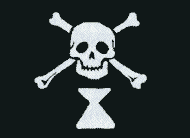In this case the idea is that in the 15th century they used stone cannon balls so that the enemy could not gather up spent balls and return fire with them. Their testing showed that a granite ball will do comparable damage to a steel ball but will shatter so that it cannot be reused. There are numerous problems with their testing and methodology.
They did their testing against "castles". That means that we are talking about siege pieces instead of field pieces. They did their testing with "Old Moses", a field piece. This is important.
Cannons were rare in the 15th century. Siege pieces were often made specifically for the siege. They shot large balls. One of the surviving 15th century siege pieces, the Great Turkish Bombard, fired balls that were nearly two feet in diameter.
Think about this. There was no standard bore since all of the cannons were custom-made for the occasion and they were used as siege pieces meaning that they were fired at the walls of a castle or city. But the myth assumes that the defenders just happen to have a cannon that uses the same size ball, that they have plenty of powder but have run out of cannon balls, and that they are willing and able to open the gates and rummage around looking for 2-foot balls of iron that they can carry inside. Plus there is the assumption that the iron balls would still be usable and retrievable.
Every part of this myth is preposterous. Even during the Spanish Armada in the 1580s, Spanish cannons were so unique that some ships had to quit firing before they ran out of powder because the only cannon balls left were for the wrong side's cannons.
During a siege, gunpowder, not balls, were normally what was in short supply. Since the attackers were normally entrenched, there was little for a siege gun to fire at, anyway.
Stone balls were used because:
- Siege pieces like the Great Turkish Bombard were not well made and needed to launch a lighter projectile or risk exploding.
- Stone was cheaper than iron. Iron casting technology was still in its infancy. The best cannons were made from bronze or brass but these metals were too expensive to use for ammunition. The Great Turkish Bombard is bronze.
- Siege engineers were used to launching stone balls since they had been used for centuries in trebuchets.
This episode made the news when a stray cannon ball bounced off of a backstop, went through three houses, and landed in a car. This happened when they added extra powder to a short, home-made cannon to see if they could get it to shoot at the same speed as Old Moses. The footage of the short cannon being fired shows that the muzzle was elevated even though it should have been firing point blank (no elevation). This probably contributed to the accident.
At times the team congratulated themselves for being the first people in five hundred years to fire a stone cannon ball. Actually, they were not even the first ones on the show to fire one. A stone ball was used when they made a cannon from a tree. Jamie retrieved the ball and used it again.
None of this has anything to do with the the Golden Age of Piracy but I know I am going to hear about it every time I bring out my cannon. It is going to be worse on the Santa Maria where we have stone balls to reduce breech pressure.

